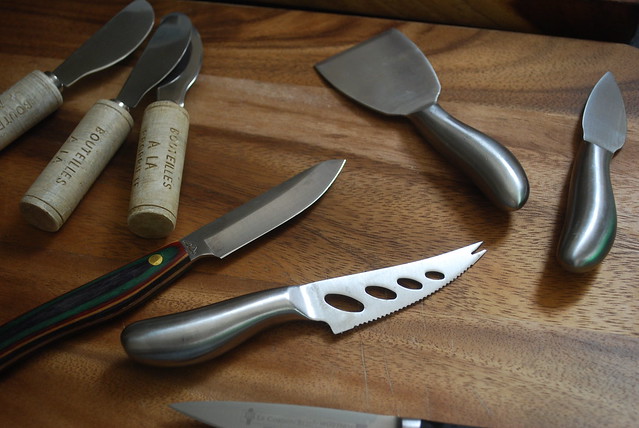Open up the latest (or just about any) kitchen store catalog, and you'll find an array of cheese knives for the "serious" entertainer. These little gadgets definitely do look pretty, but considering that they spend most of the year rolling around the kitchen drawer gathering dust, are they really necessary? I decided to break down my inventory and sort out which knife actually goes with which cheese...and which I can just go ahead and add to the Housing Works bin.
In case you're wondering...
Semi-firm and firm cheese, like Pecorino, Manchego, Parmigiano-Reggiano, or Asiago, require a good sharp knife to cut. Again, there is no need to buy a single-use sharp cheese knife; a good multi-use paring knife will work well for this purpose, and those are often small and attractive enough that they can be served along with your cheese plate when company is over. To serve, slice a few pieces ahead of time and then leave the paring knife close to the cheese on your cheese board so that guests can continue to cut other pieces for themselves.
Semi-soft cheeses like fontina, gouda, or a chilled brie are really the only kinds of cheese that should be cut and served with a proper cheese knife. You’ll easily recognize the one for the job as that knife with a sharp edge and those weird open holes along the blade. The tip will often be shaped a bit like a fork, which can be helpful for lifting the slices that you cut. The holes in the blade are there to keep the soft cheese from sticking to the knife or breaking as you slice.
Still wondering how to get those really thin shaved pieces of pecorino or parmigiano-reggiano that usually top salads in a restaurant? You don't need a special knife (often called "a cheese plane") for this either! Simply run a clean vegetable peeler run along the surface of the cheese and let the thin slices fall over your dish. (Note: this also works with a bar of chocolate to decorate a dessert!)




No comments
Hi there and thank you for reading! This blog is not currently active, so new questions are not being monitored. Please enjoy the archives.
Note: Only a member of this blog may post a comment.